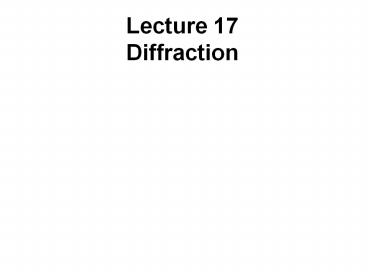Lecture 17 Diffraction - PowerPoint PPT Presentation
Title:
Lecture 17 Diffraction
Description:
Diffraction is deviation of light from a straight-line path. ... Two major types of diffraction: Fresnel and Fraunhofer. Single Slit Diffraction. Demonstration ... – PowerPoint PPT presentation
Number of Views:178
Avg rating:3.0/5.0
Title: Lecture 17 Diffraction
1
Lecture 17Diffraction
Chapter 24.6 ? 24.9
Outline
- Diffraction and Diffraction Grating
- Polarization of Light
2
Diffraction
Diffraction is deviation of light from a
straight-line path. Diffraction occurs when light
pass through small openings, bends around
obstacles, meets sharp edges.
Two major types of diffraction Fresnel and
Fraunhofer.
Fraunhofer diffraction requires a large distance
between the slit(s) and the viewing screen as
well as parallel sources of light (special case).
3
Single Slit Diffraction
Demonstration
L
a ? ?x ? sin ? ?
2 2
Condition for a dark fringe
Destructive interference sin ?d m?/a Width of
the central maximum 2?L/a
4
Diffraction Gratings
The diffraction grating is a multiple-slit
(equally-spaced) system to analyze light.
Gratings are used in spectroscopy, CD tracking,
etc. A typical grating contains thousands of
lines (slits) per millimeter.
d sin ?br m ?
For bright fringes
5
Problem with Grating
Problem A diffraction grating with 104 lines/cm
exhibits the 1st order maximum for ?510 nm at
what angle?
1 nm 10?9 m d 10?4 cm m 1
d sin ?br m ?
sin ?br 0.51 ? ?br 30.7 degrees
6
Polarization of Light
Individual atoms produce their own orientation of
the electric field (E) vector in space. The
resultant EM wave from a multiple-atom source is
a superposition of individual waves with a random
orientation of E vector. Such light is called
unpolarized.
Light is linearly polarized if the resultant
electric field vibrates only in one
direction. Three processes to polarize light
selective absorption, reflection, and scattering.
7
Summary
- Diffraction is the property of EM waves to bend
around obstacles. - Unpolarized light has the electric field vectors
vibrating in any direction, while linearly
polarized light has the electric field vector
vibrating only in one direction.































